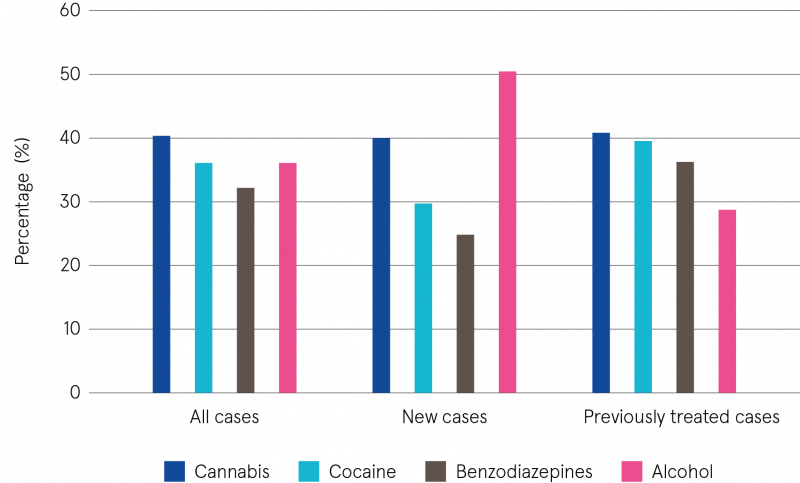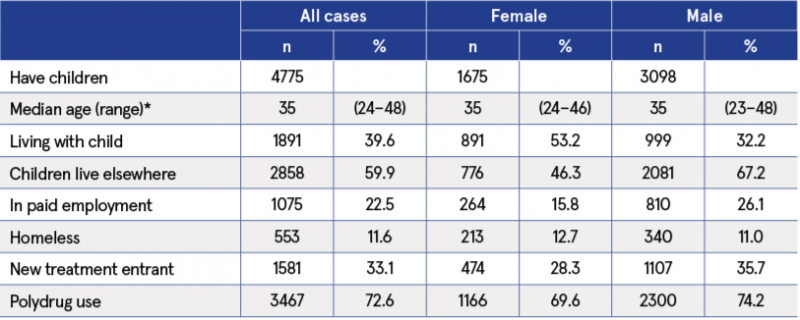O'Neill, Derek (2023) Drug treatment demand in Ireland, 2022. Drugnet Ireland, Issue 86, Summer 2023, pp. 38-43.
| Preview | Title | Contact |
|---|---|---|
|
PDF (Drugnet Ireland 86)
1MB |
Published in June 2023, the latest report from the National Drug Treatment Reporting System (NDTRS) presents data on treated problem drug use (excluding alcohol) for the year 2022, followed by trends for the seven-year period from 2016 to 2022.1
Key findings, 2022
In 2022, some 12,009 cases were treated for problem drug use.2 This is the highest annual number of cases recorded by the NDTRS to date. Almost 4 in 10 (37.1%) of those cases were never treated before, while almost 7 in 10 (68.9%) cases were treated in outpatient facilities.
Main problem drug
Cocaine was the most common main problem drug reported in 2022, accounting for one in three (34.0%) treated cases. Opioids were the second most common main problem drug reported in 2022. Heroin accounted for 86.6% of these opioid cases. Cannabis was the third most common reported main problem drug in 2022, while benzodiazepines was the fourth. Among new cases, cocaine (41.3%) was the most common main problem drug reported in 2022. Among previously treated cases, opioids (45.7%) were the most commonly reported main problem drug.

Polydrug
Problem use of more than one drug (polydrug use) was reported in over one-half of cases (56.8%) in 2022. Cannabis (40.3%) was the most common additional substance reported by cases with polydrug use, followed by alcohol (36.2%), cocaine (36.1%), and benzodiazepines (32.2%) (see Figure 1).
Among new cases with polydrug use, alcohol (50.5%) was the most common additional substance, while among previously treated cases with polydrug use, cannabis (40.8%) was the most common additional substance reported in 2022. Among cases with polydrug use, the most common drugs used together were: (i) cocaine plus alcohol, followed by (ii) cocaine plus cannabis, followed by (iii) opioids plus cocaine.

Figure 1: Additional problem substances reported and treatment status, NDTRS, 2022
Cocaine findings, 2022
In 2022, powder cocaine accounted for almost 8 in 10 treated cocaine cases (78.0%), while 2 in 10 (22.0%) were crack cocaine.
Powder
- For cases with powder cocaine as the main problem drug, nearly 8 in 10 (78.6%) were male and 4 in 10 (41.4%) were employed.
- One-half of cases entering treatment for powder cocaine were 30 years or younger.
Crack
- Where crack cocaine was the main problem drug, 4 in 10 (42.0%) were female, 6 in 10 (58.0%) were male, and less than 1 in 10 (5.6%) were employed.
- One-half of the cases entering treatment for crack cocaine were 39 years or younger.
- Crack cocaine cases resided mostly in Dublin, Kildare, Meath, and Limerick.
Age groups
Among young cases aged 19 years or younger, cannabis was the main drug generating treatment demand. Among those aged 20–34 years, cocaine was the main drug generating treatment demand, while it was opioids among those aged 35 years or older.

Sociodemographic characteristics
· The median age of cases was 33 years.
· One in seven (13.9%) cases were recorded as homeless.
· The proportion of cases with an Irish Traveller ethnicity was 3.0%.3
· Almost three in five (59.1%) cases were recorded as unemployed.
· One in five (22.0%) cases were in paid employment.
· In 2022, rates of homelessness, ceasing education before the age of 16, and unemployment were higher among previously treated cases than among new cases.
Gender
In 2022, almost 3 in 10 (27.9%) cases were female, while 13 cases identified as non-binary or in another way.4
Females
- The median age was 34 years, while the median age for new cases was 29 years.
- One in two (51.5%) cases were under 35 years of age.
- 5.7% were aged 50 years or over.
- 13.6% were homeless.
- For one-half of female cases, the time lag between first use of the main problem drug and seeking treatment was 7 years or longer.
- 55.9% reported polydrug use, most commonly cannabis and cocaine.
- Among females, the most common main problem drugs were opioids (37.0%), followed by cocaine (31.6%) and cannabis (16.1%). The same drugs were also most common among new female cases entering drug treatment for the first time. However, the order was different, with cocaine (34.8%) being the most frequent, followed by cannabis (30.5%) and then opioids (18.5%).
Males
- The median age was 32 years, while the median age for new cases was 27 years.
- The majority (56.7%) were under 35 years of age.
- 5.9% were aged 50 years or over.
- 14.0% were homeless.
- For one-half of male cases, the time lag between first use of the main problem drug and seeking treatment was 8 years or longer.
- Among males, the most common main problem drugs reported were cocaine (35.0%), followed by opioids (31.6%) and cannabis (19.6%). The same drugs were also most common among new male cases entering drug treatment for the first time. However, the order was different, with cocaine (43.5%) being the most frequent, followed by cannabis (33.4%) and then opioids (11.8%).
- 57.1% reported polydrug use, most commonly cannabis and alcohol.
Parental status
In 2022, almost one-half of cases (47.3%) in drug treatment were parents who had children. Where parents were known to have children aged 17 years or younger, 39.6% had at least one child residing with them at the time of treatment entry, while 59.9% had at least one child residing elsewhere (see Table 1).5,6 A higher proportion of females entering drug treatment reported having dependent children and living with children, while males were more likely to not be residing with their children.
Table 1: Cases treated for drugs with children aged 17 years or younger, 2022

* Age range presented is 5th percentile to 95th percentile (90% of cases are included within this range).
Trends over time, 2016–2022
Between 2016 and 2022, a total of 71,567 cases treated for problem drug use (excluding alcohol) were reported to the NDTRS.
Main problem drug, 2016–2022
Over the seven-year period 2016–2022, opioids (mainly heroin) were the most common drug type reported, followed by cocaine and cannabis. Trends have changed over the time period, however, and in 2022 cocaine was the most common main problem drug reported. The proportion of cases treated for cocaine as a main problem increased from 12.3% in 2016 to 34.0% in 2022. Over the period 2016–2022, there was a 258.9% increase in the number of cases where cocaine was the main problem drug. As a proportion of all cases treated, opioids decreased year-on-year, from 47.0% in 2016 to 33.1% in 2022. Heroin accounted for 86.6% of all opioid cases in 2022.
The proportion of cases treated for cannabis as a main problem decreased from 26.4% in 2016 to 18.7% in 2022.
New cases, 2016–2022
Among new cases, cocaine as a main problem increased yearly from 16.1% in 2016 to 41.3% in 2022, a 223.8% increase in the number of cases. The proportion of opioids decreased steadily from 26.9% in 2016 to 12.6% in 2021 and increased to 13.4% in 2022.
Previously treated cases, 2016–2022
Among previously treated cases, the most common main problem drugs reported were opioids, cocaine, and benzodiazepines. Decreasing trends were observed among previously treated cases for opioids and cannabis, while increasing trends were observed for cocaine and benzodiazepines as main problem drugs.
Risk behaviour, 2016–2022
The proportion of all cases that had ever injected decreased year-on-year, from 32.1% in 2016 to 20.8% in 2022. Over the seven-year period, there was a 15.8% decrease in the number of cases reporting that they had ever injected. Among new cases, the proportion that reported ever injecting decreased over the period from 13.5% in 2016 to 4.4% in 2022. The proportion of previously treated cases that reported ever injecting decreased from 44.6% in 2016 to 31.3% in 2022. In 2022, some 42.7% of cases that had ever injected had also shared needles and syringes, an increase on 37.2% in 2019.
1 O’Neill D, Lyons S and Carew A (2023) National Drug Treatment Reporting System: 2022 drug treatment demand. HRB StatLink Series 12. Dublin: Health Research Board. Available from: https://www.drugsandalcohol.ie/38794
2 NDTRS data are case-based, which means there is a possibility that individuals appear more than once in the database; for example, where a person receives treatment at more than one centre or at the same centre more than once in a calendar year.
3 Based on the 2016 Census from the Central Statistics Office (2022), the proportion of Irish Travellers in the general population is 0.7%. Available from: https://www.cso.ie/en/releasesandpublications/ep/p-cp8iter/p8iter/p8e/
4 Non-binary describes gender identities outside of the female–male gender binary. Individuals identifying as non-binary may feel neither exclusively male nor female, both male and female, or between or beyond genders.
5 Service users currently residing with children refers to the 30 days prior to treatment. This includes children where the service user has a carer or guardianship role; non-related children such as foster children and stepchildren; and the children of a long-term cohabiting partner. Where the service user is a grandparent or other close relative and is the official guardian of a child with whom they are living, they are recorded as living with children.
6 Children who are not residing with the service user refers to children currently living with another parent; children in formal care or informal care; and children living elsewhere who are biological children/adopted children, or children who are under the official guardianship of the service user. It also refers to children who have left home and to children who are living with other family members or friends temporarily, but who are not considered by the service user to be living in care.
Repository Staff Only: item control page